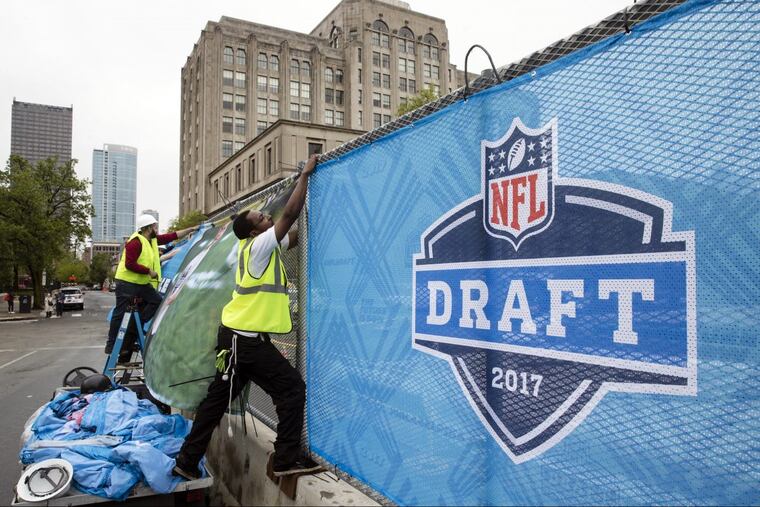NFL draft in Philly attracted 250,000 visitors and generated $94.9M in economic impact
The April draft drew a record crowd here and generated more than the initial estimates in economic impact and direct spending by visitors, a report says.

The NFL draft was a tourism boon for Philadelphia and delivered $94.9 million in economic impact to the city, exceeding expectations, according to a new report.
The three-day event along Benjamin Franklin Parkway in April drew a record-breaking 250,000 football fans, who directly spent $56.1 million in hotels, restaurants, bars, and retail shops, said the study commissioned by the Philadelphia Convention & Visitors Bureau and conducted by Temple University's Sport Industry Research Center. The study estimated an additional $38.8 million was generated in indirect and induced spending.
The total $94.9 million in economic impact exceeded initial expectations of $80 million; it was one of the most successful NFL drafts since the first in 1936.
"Philadelphia served as a phenomenal host," said Peter O'Reilly, NFL senior vice president of events, "and created a memorable experience for our fans, incoming players, and teams."
The city spent about $500,000 to host the draft. "We were reimbursed for any costs over $500,000," said Mayor Kenney's spokeswoman, Lauren Hitt. "The $500,000 would include anything the city spent. It could range from first-responder services, to streets cleanup, to special events, to health inspectors in the food tents. It would cover a whole range of things."
Both the Convention & Visitors Bureau and Temple declined to say what the economic-impact study cost, except that it covered Temple's research expenses.
The 250,000 participants in the April 27-29 event were the largest crowd in NFL draft history. Of those, 63 percent were from out of town and 17 percent stayed overnight at paid accommodations such as hotels and Airbnb sites, the report said.
Those who flocked to the Parkway, where an outdoor theater was built outside the Art Museum, came from 42 states. The report was based on a post-event survey of 4,794 attendees. Of those, 93 percent said the draft was the primary reason for their visit, 79 percent said they would recommend Philadelphia as a travel destination, and 62 percent said they plan to return to Philadelphia for a vacation within the next 12 months.
Hotel-room revenue — 80 percent of which was within the city — was up 11.4 percent year over year during the draft's peak days. The event generated an additional $2.1 million in room revenue for regional hotels compared with levels of one year ago and an extra $1.2 million in Philadelphia itself. The 18,991 hotel room nights sold, however, were below initial projections.
"From my perspective, what's critical is the revenue generated," said Jeremy Jordan, professor and associate dean of Temple University's School of Sport, Tourism and Hospitality Management, who led the Philadelphia study and similar studies of the 2015 and 2016 NFL drafts in Chicago.
"What we found is that a higher percentage of people stayed with friends and family than what we saw in Chicago," Jordan said. "More than one-third of the people who stayed overnight stayed with family and friends. One of the values of having this event in Philadelphia is that you can draw from the large metropolitan areas that are close – New York, Washington, D.C., Baltimore. I think a lot of people just came in for the day and went home."
The draft, which packed restaurants and kept area attractions busy, helped support more than 30,000 jobs (914 full-time equivalent positions) and helped generate an estimated $38.5 million in personal income and $7.9 million in state and city taxes from income tax, sales tax, and hotel tax, the report said.
The draft attracted more than 1,800 members of the media to the city, and between Sept. 1, 2016 — when Philadelphia won the bid to host the 2017 NFL draft — through May 2017, the Convention & Visitors Bureau tracked 2,352 print, digital, and broadcast draft-related stories mentioning Philadelphia.
The first round of the draft was the "most-watched" cable program and most-watched sports event of the week on both broadcast and cable networks, the report noted.
The Inquirer and Daily News reported in April that in Chicago, the NFL draft generated about $81 million in total economic impact in 2015 and 2016 and crowds estimated at 200,000.
Philadelphia broke draft-attendance records because of this region's passion for sports, especially the Eagles, and its accessibility to several NFL markets, said Larry Needle, executive director of PHL Sports, a division of the Convention & Visitors Bureau.
"If you looked out on that Parkway, you had fans wearing Ravens jerseys, Bills jerseys, Steelers, Giants, and Jets jerseys," he said. "It was a melting pot of football fans from around the country."
Philadelphia would like to host the NFL draft again, but the league has not yet announced the location of next year's event. Twenty cities have made pitches.
"We definitely have expressed our interest," Needle said. "We expect within a fairly short period of time to hear what direction they are moving."